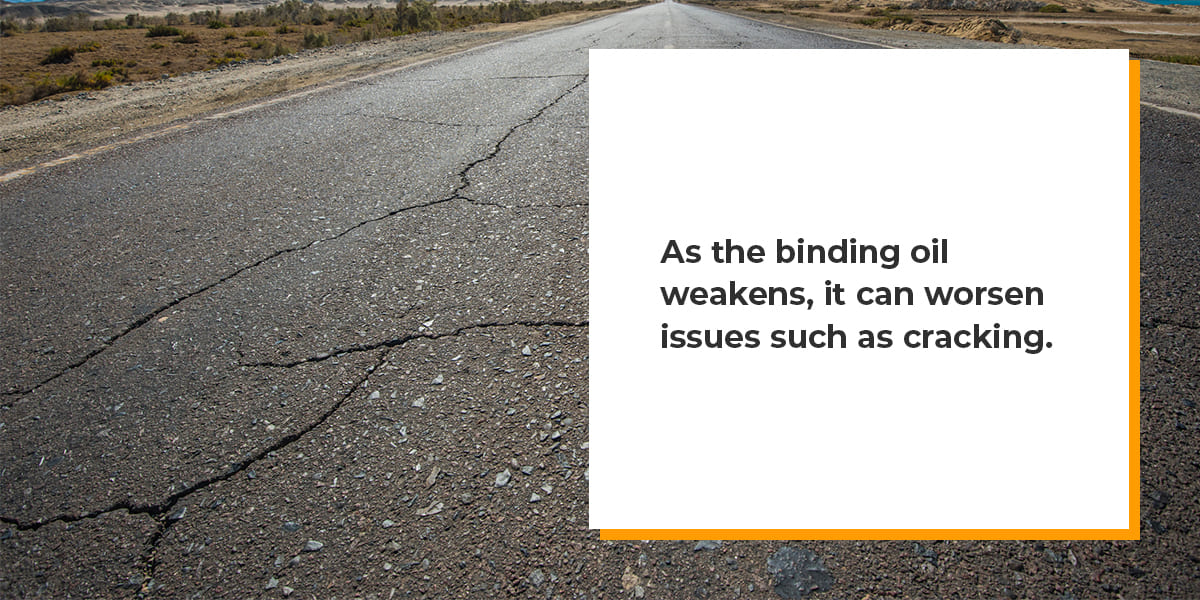Weather conditions can affect asphalt in many ways. Like numerous construction materials, asphalt contracts in cold temperatures and expands in warm temperatures. While asphalt can usually handle these fluctuations, a sudden dip in temperature may cause cracks. Alternatively, a temperature spike might cause slab buckling. Another weather effect on asphalt is moisture — water that stays in place too long may begin to dissolve and erode the asphalt.
Learn how the season can affect your asphalt parking lots, blacktops and walkways, and what you can do to prevent damage on a commercial property you manage.
Spring and Summer Effects on Asphalt
Florida’s warm season is one of the longest and hottest in the country, making the effects of heat and sunshine on asphalt more prevalent. Asphalt is also less resistant to heat damage than cold weather issues, which can multiply the impact. Property managers should be aware of many heat- and sun-related risks, such as:
1. Cracking and Potholes
Prolonged heat exposure and sudden spikes in temperature can cause asphalt to expand. When it expands too quickly, it can break apart, causing cracks. If the asphalt is exceptionally rigid, high heat can cause it to buckle and create potholes.
2. Tracking
On sweltering days, especially in Florida, you might notice your asphalt beginning to melt. When hot weather softens the pavement significantly, tiny flecks stick to shoes and tires, tracking their way into your building. Here, excess heat and humidity can slow down the curing process when applying new asphalt. When asphalt takes longer to cure, tracking is more common.
3. Hot Pavement
Black asphalt absorbs heat. This ability can be a benefit because warmer asphalt is more pliable, which helps it withstand lots of traffic without cracking. However, it can also make the parking lot hotter, adding to people’s discomfort on a scorching day. The hot surface can also be dangerous for pets to walk on.
4. Fading
While the sun’s damaging ultraviolet (UV) rays beat down on us during any season, they’re particularly strong in the spring and summer. UV light causes asphalt’s rich black color to fade over time. UV light can also fade the line striping, making it harder to see. As the pavement turns gray and the white lines disappear, safety markings can become nearly invisible.
Luckily, this effect is easy to mitigate with sealcoating. Sealcoating adds a dark black sealant to the pavement that restores its color and provides a UV-protective barrier. Restriping can restore your lines to a bright white.
5. Oxidation
Another concern stemming from the sun’s UV radiation is oxidation. UV light reacts with the light and heavy oils within the asphalt, causing the two to combine, weakening their binding properties. As the binding oil weakens, it can worsen issues such as cracking.
6. Rain and Moisture Damage
Florida’s rainy season begins around mid-May and lasts through early October. During the rainy season, our state often sees heavy rains and flooding, which increases opportunities for moisture damage. If the asphalt already has a crack, water can seep into the asphalt and weakens the subsurface — usually compacted soil. Once the compacted subsurface weakens, a bit of pressure, such as a car driving over it, can depress the asphalt and cause a pothole.
Once potholes form, rainy weather poses another issue — deep puddles. Puddles can make your parking lot messy and harder to walk through. They also mask potholes, which means drivers may not slow down as they’re driving through them, creating safety concerns.
At the surface level, rainwater can wash away the oils that bind together asphalt’s stone and gravel aggregate. Over time, rainwater can erode at the surface until only bare rocks and aggregate remain. These pieces can break off and leave hazards for drivers or end up in storm drains.
Sealcoating can help reduce water penetration, which can prevent many asphalt issues during the rainy season. If you have any potholes, it’s crucial to address them quickly to avert pooling problems before they cause safety hazards and impact your customer experience.
Fall and Winter Effects on Asphalt
Florida has exceptionally mild winters. January, the coldest month of the year, sees average lows around the 30s in the north and comfortable averages of 70 degrees in the southern region. These relatively mild conditions minimize the effects of snow, ice and cold temperatures on asphalt. Asphalt is also more resistant to cold-weather concerns than its counterpart concrete. Here in Florida, property owners can expect relatively minor damage due to fall and winter weather.
However, the occasional cold snap can still do a number on your asphalt. Some of the effects to consider include:
Cracking
Just as heat expanding the asphalt can cause cracks, cold temperatures cause the pavement to contract, creating cracks. On average, South Florida’s rural and interior parts experience a hard freeze once every 10 years and more often in the northern part of the state.
While that may not seem like much to worry about, consider the average lifespan of an asphalt parking lot. In the 15-30 years you can expect out of your lot, you may experience harsh freezing conditions up to three times or more, on average. Plus, the fact that these weather events can come on so suddenly increases the chance of cracking due to the more rapid contraction.
Icy Conditions
While relatively uncommon, the occasional Florida cold wave can create a safety hazard in the form of ice. Black ice is hazardous because it blends in with the asphalt. On foot, ice is a slipping hazard. It can also make drivers lose control of their vehicles. These conditions represent liabilities for lot owners and require your swift attention. Luckily, salt and ice melt don’t damage asphalt as they do concrete.
More Reliable Curing
Some good news for Florida lot owners is that fall and winter are great times to pave. Excess heat and humidity are difficult to escape here in the spring and summer months. These conditions slow curing time, which can have long-lasting effects even after the pavement has fully cured. Paving in the winter can present difficulties in colder climates because the extreme cold and high wind speeds make it harden faster, limiting the time pavers can work.
However, our mild winters with comfortable temperatures and less humidity make the fall and winter two of the best seasons to have your parking lot repaved.
Contact ToriTom Services for Year-Round Commercial Asphalt Maintenance
ToriTom Services specializes in commercial asphalt repair and maintenance. We can help to prevent cracking, potholes and many other weather-related issues with regular sealcoating and additional preventive measures. We’ll also repair the effects of weather damage by fixing cracks, replacing damaged portions, restriping and repaving or overlaying your commercial property as needed.
We service all of Florida, and we’re particularly well-equipped to help commercial properties prevent issues related to warm weather. Contact the ToriTom Services team to discuss your commercial property maintenance needs today.



